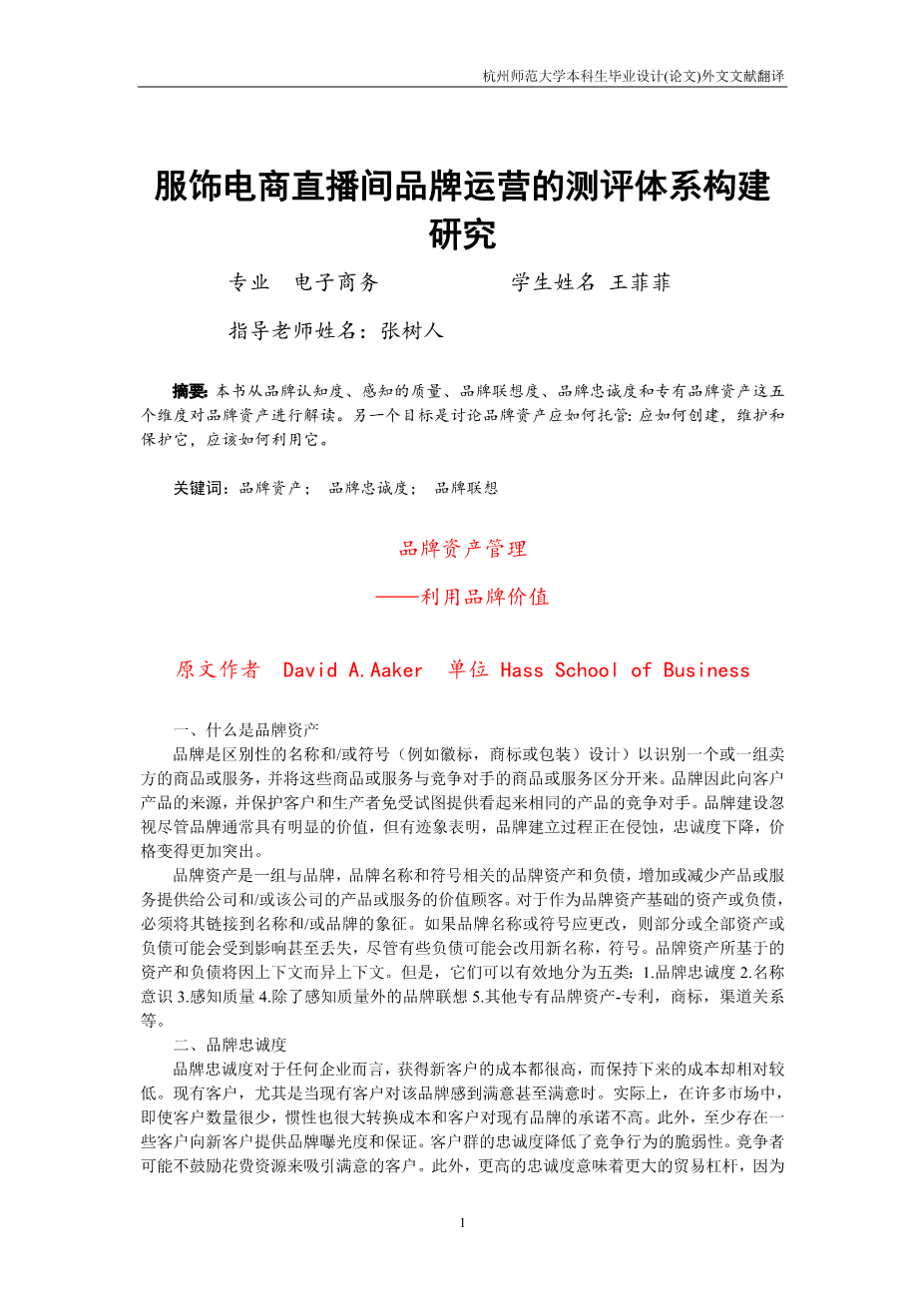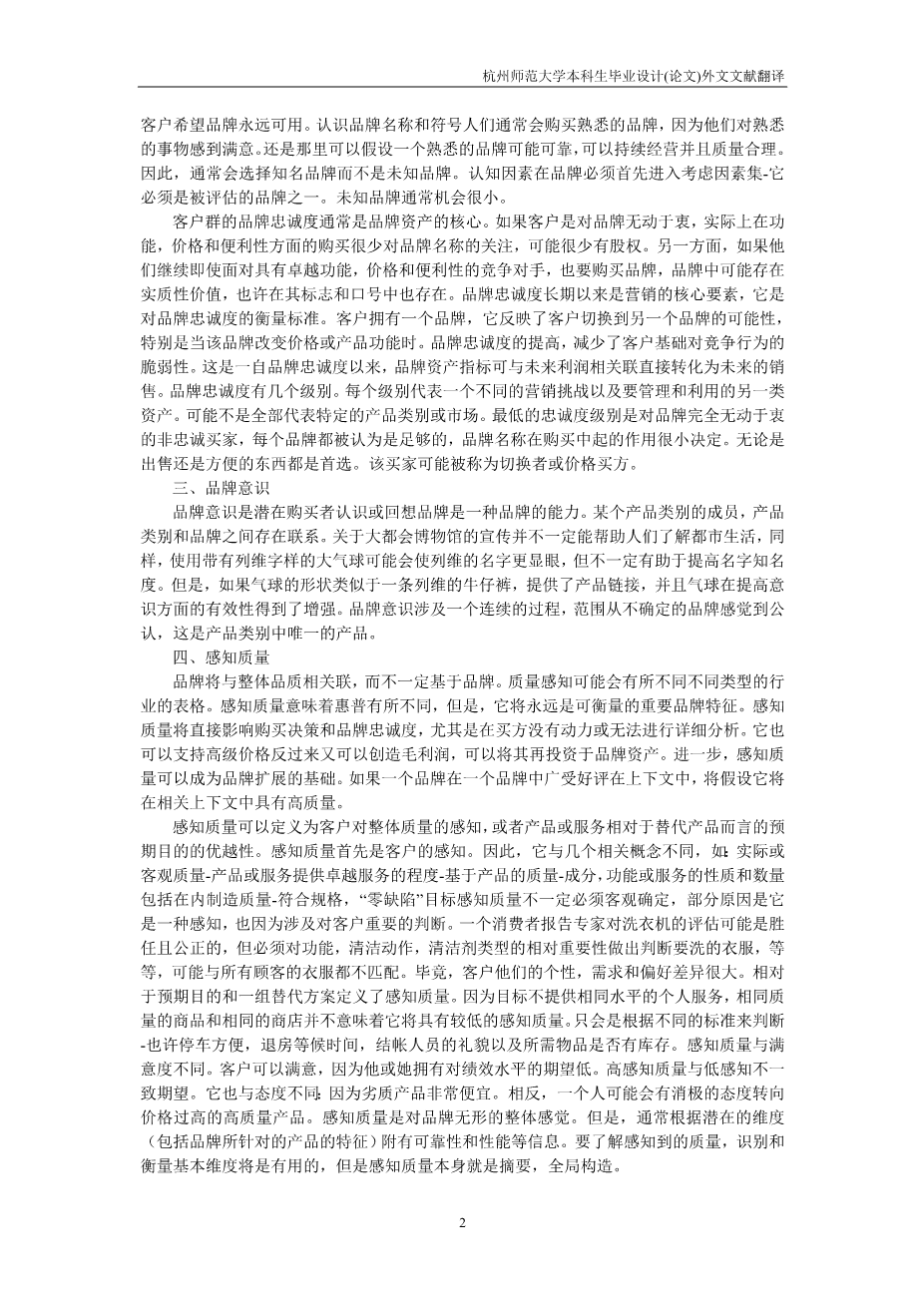

英语原文共 7 页,剩余内容已隐藏,支付完成后下载完整资料
THE ROLE OF BRANDS
THE ROLE OF BRANDS A brand is a distinguishing name and/or symbol (such as a logo, trademark, or package design) intended to identify the goods or services of either one seller or a group of sellers, and to differentiate those goods or services from those of competitors. A brand thus signals to the customer the source of the product, and protects both the customer and the producer from competitors who would attempt to provide products that appear to be identical.
Brand equity is a set of brand assets and liabilities linked to a brand, its name and symbol, that
add to or subtract from the value provided by a product or service to a firm and/or to that firmrsquo;s
customers. For assets or liabilities to underlie brand equity they must be linked to the name and/or
symbol of the brand. If the brandrsquo;s name or symbol should change, some or all of the assets or
liabilities could be affected and even lost, although some might be shifted to a new name and
symbol. The assets and liabilities on which brand equity is based will differ from context to
context. However, they can be usefully grouped into five categories:
1. Brand loyalty
2. Name awareness
3. Perceived quality
4. Brand associations in addition to perceived quality
5. Other proprietary brand assets—patents, trademarks, channel relationships, etc.
BRAND LOYALTY
For any business it is expensive to gain new customers and relatively inexpensive to keep existing ones, especially when the existing customers are satisfied with—or even like—the brand. In fact, in many markets there is substantial inertia among customers even if there are very low switching costs and low customer commitment to the existing brand. Thus, an installed customer base has the customer acquisition investment largely in its past. Further, at least some existing customers provide brand exposure and reassurance to new customers. The loyalty of the customer base reduces the vulnerability to competitive action. Competitors may be discouraged from spending resources to attract satisfied customers. Further, higher loyalty means greater trade leverage, since customers expect the brand to be always available.
The brand loyalty of the customer base is often the core of a brandrsquo;s equity. If customers are indifferent to the brand and, in fact, buy with respect to features, price, and convenience with little concern to the brand name, there is likely little equity. If, on the other hand, they continue to purchase the brand even in the face of competitors with superior features, price, and convenience, substantial value exists in the brand and perhaps in its symbol and slogans. Brand loyalty, long a central construct in marketing, is a measure of the attachment that a customer has to a brand. It reflects how likely a customer will be to switch to another brand,
especially when that brand makes a change, either in price or in product features. As brand loyalty increases, the vulnerability of the customer base to competitive action is reduced. It is one indicator of brand equity which is demonstrably linked to future profits, since brand loyalty directly translates into future sales.
BRADN AWARENESS
Brand awareness is the ability of a potential buyer to recognize or recall that a brand is a member of a certain product category. A link between product class and brand is involved. Publicity about the Metropolitan Museum does not necessarily help the awareness of Metropolitan Life. Similarly, the use of a large balloon with the word Levirsquo;s on it may make the Levi name more salient, but it will not necessarily help improve name awareness. However, if the balloon is shaped to resemble a pair of Levirsquo;s 301 jeans, the link to the product is provided, and the balloonrsquo;s effectiveness at creating awareness is enhanced.
PERCEIVED QUALITY
A brand will have associated with it a perception of overall quality not necessarily based on a knowledge of detailed specifications. The quality perception may take on somewhat different forms for different types of industries. Perceived quality means something different for Hewlett Packard or IBM than for Solomon Brothers or Tide or Heinz. However, it will always be a measureable, important brand characteristic.
Perceived quality will directly influence purchase decisions and brand loyalty, especially when a buyer is not motivated or able to conduct a detailed analysis. It can also support a premium price which, in turn, can create gross margin that can be reinvested in brand equity. Further, perceived quality can be the basis for a brand extension. If a brand is well-regarded in one context, the assumption will be that it will have high quality in a related context.
Perceived quality can be defined as the customerrsquo;s perception of the overall quality or superiority of a product or service with respect to its intended purpose, relative to alternatives.2 Perceived quality is, first, a perception by customers. It thus differs from several related concepts, such as: 80
Actual or objective quality—the extent to which the product or service delivers superior service Product-based quality—the nature and quantity of ingredients, features, or services included Manufacturing quality—conformance to specification, the “zero defect” goal Perceived quality cannot necessarily be objectively determined, in part because it is a perception and also because judgments about what is important to customers are involved. An evaluation of washing machines by a Consumer Report expert may be competent and unbiased, but it must make judgments about the relative importance of features, cleaning action, types of clothes to be washed, and so on that may not match those of all customers. After all, customers differ sharply in their personalities, needs, and prefere
剩余内容已隐藏,支付完成后下载完整资料
资料编号:[268627],资料为PDF文档或Word文档,PDF文档可免费转换为Word
您可能感兴趣的文章
- 基于4P模型和品牌的路易威登中国营销策略分析外文翻译资料
- “互联网 ”背景下的电子商务对国际经济和贸易的影响外文翻译资料
- 四川达州农村电商生态系统建设中的问题与对策外文翻译资料
- 品牌年轻化策略对消费者购买意愿的影响研究外文翻译资料
- 后疫情时代咖啡企业新零售营销策略研究——以瑞幸为例外文翻译资料
- 中国精品咖啡电商市场营销研究 ——基于消费者行为视角外文翻译资料
- 基于社交网络的跨境电商用户购买行为影响因素的实验探索——以小红书为例外文翻译资料
- 基于数据仓库的培训机构信息管理系统的设计与实现外文翻译资料
- 支持在线学习环境和慕课中的自我调节学习:系统综述外文翻译资料
- 中日韩FTA对中国制造业的影响研究外文翻译资料


